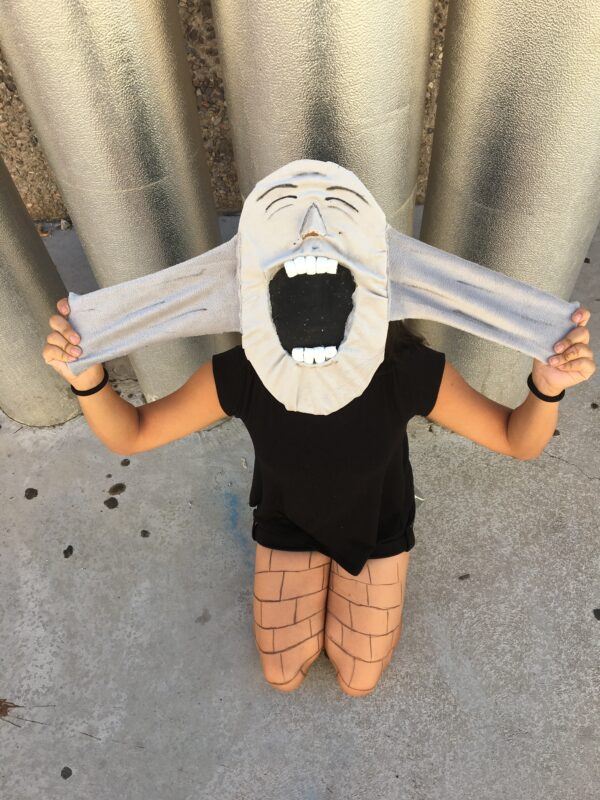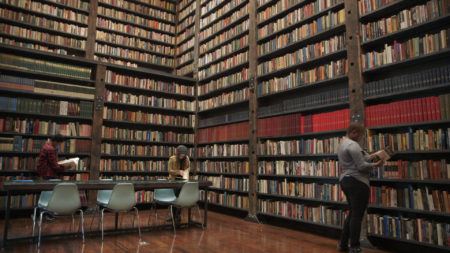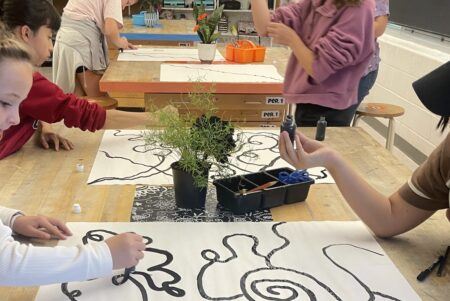Teaching with Contemporary Art
Unveiling the Power of Persona

Courtesy of Lizz Denneau.
I’m sure all art educators agree that our work is vital in nurturing creativity, self-expression, and critical thinking among our high school artists. These years lend themselves to identity exploration, the trying on of roles, and the imagining of future selves. Art education can help our young artists explore these themes in important and self-affirming ways. One approach that can ignite students’ artistic imagination is the exploration of persona and alter ego. I draw lesson inspiration from contemporary artists like Nick Cave and Alex Da Corte. These artists seamlessly blend themes of identity, transformation, and storytelling to create artwork that invites students to embark on an introspective journey, encouraging them to think outside the box and delve into their creative depths.

Courtesy of Lizz Denneau.
Nick Cave, renowned for his captivating “Soundsuits” and assemblage installations, introduces students to the concept of persona through wearable sculptures that simultaneously conceal and reveal identity. The opulence and maximalism used in his materials appeal to many of my students. Students can examine the transformative power of these suits, discussing how donning a new physical form can allow them to explore different facets of themselves. By designing their own Soundsuits and engaging in movement-based performances, students can step into the shoes of an alter ego, gaining firsthand experience of how artistic expression can transcend traditional boundaries and challenge societal norms. I always start with Art21’s “Chicago” episode when introducing my students to Cave’s work. It’s a perfect example of his process, the labor involved in his suits and performances, and the context in which he’s working. I was lucky to catch his retrospective show at the Museum of Contemporary Art in Chicago last year. I was moved by his materials and the transitions he has made from his earlier work to now. I invite my students to explore his recent assemblages and discuss how his materials act as code for more significant themes throughout all manifestations of his work.

Courtesy of Lizz Denneau.
Alex Da Corte’s artworks provide an excellent platform for students to explore the multifaceted nature of persona and alter ego. His diverse characters and narratives encourage students to investigate how personas can be used as vehicles for emotional expression and storytelling. My students always respond to Da Corte’s vulnerability and curiosity throughout his work and his use of nostalgia in anchoring identities. We take time as a group to analyze the layering of iconography within his character vignettes. Art21’s recent episode “Everyday Icons“, featuring Da Corte, is fantastic for facilitating these discussions.
Through group discussions, my students analyze how artists like Cave and Da Corte challenge societal norms and engage with themes of race, gender, and individuality through mediums like popular culture and performance. My students are empowered to critically examine their own identities and the societal constructs that influence them. By using persona as a tool for dialogue, students develop a greater awareness of the complexities of human experience and gain insights into the broader cultural context.

Courtesy of Lizz Denneau.
After we’ve spent some time exploring these artists, my students start the work of creating their personas or alter egos. I give them the option to work in groups to make one collective identity or to work solo, inviting them to collaborate with each other on their performance piece. They start with the rough draft and move into making a materials list. We break down the construction into steps: “What must you build first?” “What comes next?” and so on. The performance piece, I find, is more organic and realized through building the persona. Some students know immediately what their movements might be, while others must be in the costume for it to be totally realized. This part is incredibly fun to observe as they explore the power of their new identities and the freedom they can provide. Students record short videos on their phones, and I compile them into a film we all watch together. There is, of course, popcorn. In other years, they have performed around the school grounds and a version of a flash mob. Through painting, sculpture, and multimedia installations, students can experiment with creating their personas, infusing their artwork with deeper meanings and narratives inspired by their personal experiences. This process enhances their artistic skills and fosters empathy and an understanding of diverse perspectives.

Courtesy of Lizz Denneau.
Incorporating persona and alter ego in high school art education goes beyond technique and aesthetics—it fosters personal growth and creative exploration. Students learn about the artistic process and develop crucial self-reflection, empathy, and communication skills. By drawing inspiration from artists like Nick Cave and Alex Da Corte, educators can guide students in harnessing the power of alter egos to create thought-provoking artwork that challenges conventions, pushes boundaries, and opens doors to a world of limitless artistic possibilities. Through this journey, students become active participants in the dynamic conversation between art, identity, and societal narratives.



